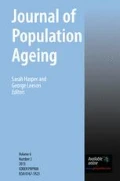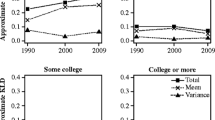Abstract
In this paper, we use the concept of prospective age to illuminate patterns of aging by gender, and education in Europe. We find that, within countries, the patterns of aging of men and women with high education are comparatively similar to one another, but that the patterns of aging are quite dissimilar for men and women in the low education group. Across countries the patterns of aging become more similar as education levels increase. Thus, when we look across educational strata, we find increasing convergence in the pattern of aging both across countries and by gender within countries. The distinctive patterns of aging in the Eastern European countries are largely associated with the comparatively rapid aging of men in the low education category. If aging patterns by education persist, improvements in the education composition of Eastern European countries would result in the patterns of aging there becoming more similar to those in Western European countries.







Similar content being viewed by others
References
Bray, I., Brennan, P., & Boffetta, P. (2000). Projections of alcohol- and tobacco-related cancer mortality in Central Europe. International Journal of Cancer, 87(1), 122–128.
Eurostat (2013). Life expectancy by age, sex, and educational attainment (ISCED 1997). European Union. http://appsso.eurostat.ec.europa.eu/nui/show.do?dataset=demo_mlexpecedu&lang=en. Accessed 2 June 2014.
Hummer, R. A., & Hernandez, E. M. (2013). The effects of educational attainment on adult mortality in the United States. Population Bulletin, 68(1), 1–18.
Hummer, R. A., & Lariscy, J. T. (2011). Educational attainment and adult mortality. In R. G. Rogers & E. M. Crimmins (Eds.), International handbook of adult mortality (pp. 241–261). Netherlands: Springer.
Kitagawa, E. M., & Hauser, P. M. (1968). Education differentials in mortality by cause of death: United States, 1960. Demography, 5(1), 318–353.
Kulik, M. C., Menvielle, G., Eikemo, T. A., Bopp, M., Jasilionis, D., Kulhánová, I., et al. (2014). Educational inequalities in three smoking-related causes of death in 18 European populations. Nicotine & Tobacco Research, 16(5), 507–518.
Leinsalu, M., Vågerö, D., & Kunst, A. E. (2003). Estonia 1989–2000: enormous increase in mortality differences by education. International Journal of Epidemiology, 32(6), 1081–1087.
Leon, D. A. (2011). Trends in European life expectancy: a salutary view. International Journal of Epidemiology, 40(2), 271–277.
Lutz, W., Sanderson, W. C., & Scherbov, S. (2008). The coming acceleration of global population ageing. Nature, 451(7179), 716–719.
Lutz, W., Butz, W. P., & Samir, K. C. (2014). World population and human capital in the 21st century. Oxford: Oxford University Press.
Mäki, N. E., Martikainen, P. T., Eikemo, T., Menvielle, G., Lundberg, O., Östergren, O., & Mackenbach, J. P. (2014). The potential for reducing differences in life expectancy between educational groups in five European countries: the effects of obesity, physical inactivity and smoking. Journal of Epidemiology and Community Health, 68(7), 635–640.
McCartney, G., Mahmood, L., Leyland, A. H., Batty, G. D., & Hunt, K. (2011). Contribution of smoking-related and alcohol-related deaths to the gender gap in mortality: evidence from 30 European countries. Tobacco Control, 20(2), 166–168.
Montez, J. K., Hummer, R. A., Hayward, M. D., Woo, H., & Rogers, R. G. (2011). Trends in the educational gradient of U.S. adult mortality from 1986 through 2006 by race, gender, and age group. Research on Aging, 33(2), 145–171.
Olshansky, S. J., Antonucci, T., Berkman, L., Binstock, R. H., Boersch-Supan, A., Cacioppo, J. T., et al. (2012). Differences in life expectancy due to race and educational differences are widening, and many may not catch up. Health Affairs, 31(8), 1803–1813.
Rehm, J., Sulkowska, U., Mańczuk, M., Boffetta, P., Powles, J., Popova, S., & Zatoński, W. (2007). Alcohol accounts for a high proportion of premature mortality in central and eastern Europe. International Journal of Epidemiology, 36(2), 458–467.
Sanderson, W. C., & Scherbov, S. (2007). A new perspective on population aging. Demographic Research, 16, 27–58.
Sanderson, W. C., & Scherbov, S. (2008). Rethinking age and aging. Washington, D.C.: Population Reference Bureau.
Sanderson, W. C., & Scherbov, S. (2013). The characteristics approach to the measurement of population aging. Population and Development Review, 39(4), 673–685.
Shkolnikov, V. M., Andreev, E. M., Jasilionis, D., Leinsalu, M., Antonova, O. I., & McKee, M. (2006). The changing relation between education and life expectancy in central and eastern Europe in the 1990s. Journal of Epidemiology and Community Health, 60(10), 875–881.
United Nations. (2013). World population ageing 2013 (No. ST/ESA/SER.A/348). New York: Department of Economic and Social Affairs, Population Division.
Acknowledgments
The research leading to these results has received funding from the European Research Council under the European Union’s Seventh Framework Programme (FP7/2007-2013) / ERC grant agreement no ERC2013-AdG 323947-Re-Ageing.
Author information
Authors and Affiliations
Corresponding author
Electronic supplementary material
Below is the link to the electronic supplementary material.
ESM 1
(PDF 169 kb)
Rights and permissions
About this article
Cite this article
Sanderson, W.C., Scherbov, S. A New Perspective on Patterns of Aging in Europe by Education and Gender. Population Ageing 9, 207–225 (2016). https://doi.org/10.1007/s12062-015-9125-z
Received:
Accepted:
Published:
Issue Date:
DOI: https://doi.org/10.1007/s12062-015-9125-z




